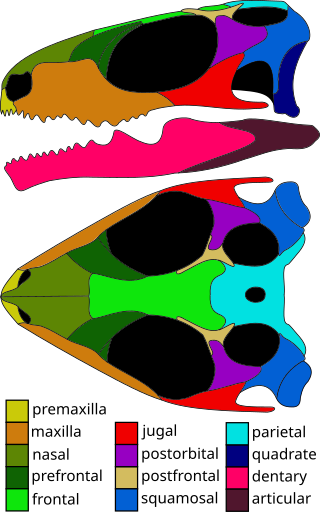Top Qs
Timeline
Chat
Perspective
Planocephalosaurus
Extinct genus of reptiles From Wikipedia, the free encyclopedia
Remove ads
Planocephalosaurus is an extinct genus of basal rhynchocephalian. Fossils of the genus are primarily known from fissure fill deposits from the Late Triassic of southwest Britain, with fragmentary remains possibly belonging to the genus also known from the Late Triassic of Texas.
Remove ads
Taxonomy
Summarize
Perspective
The genus and the type species P. robinsonae was described in 1982 by Fraser from remains found in fissure fill deposits in Gloucestershire in southwest Britain.[1] In 2004, a second species P. lucasi was described from remains found in the Tecovas Formation in Texas.[2] P. robinsonae is known from disarticulated remains covering most of the skeleton,[1][3], while P. lucasi is known from fragments of the jaws.[2][4] While originally classified in Sphenodontidae,[1] later studies have placed it as a basal sphenodontian, more derived than Diphydontosaurus but more basal than Clevosaurus.[5]
Cladogram after:[6]
| ||||||||||||||||||||||||||||
Remove ads
Description

Planocephalosaurus robinsonae was a small sphenodontian, with a skull length of around 2 centimetres (0.79 in),[1] with a total length of around 14.5–16 centimetres (5.7–6.3 in).[3] Unlike the modern tuatara, the skull is thought to lack a complete lower temporal bar connecting the jugal and the quadrate, though a complete temporal bar may have been variably present in some adult individuals.[1] While initially suggested to have had fully acrodont dentition,[1] later X-ray analysis suggested that the teeth at the front of the jaws of Planocephalosaurus were attached to a shelf on the inward side of the jaw, technically making them pleurodont, though they had some characters typically associated with acrodonty, such as having no clear boundary between the teeth and jaw bone. The back of the jaws had enlarged fully acrodont teeth fused to the apex of the jaw bone, similar to Diphydontosaurus.[1][7][8]
Remove ads
Ecology
Planocephalosaurus is thought to have been insectivorous, with it possibly also feeding on small vertebrates.[1]
References
Wikiwand - on
Seamless Wikipedia browsing. On steroids.
Remove ads

